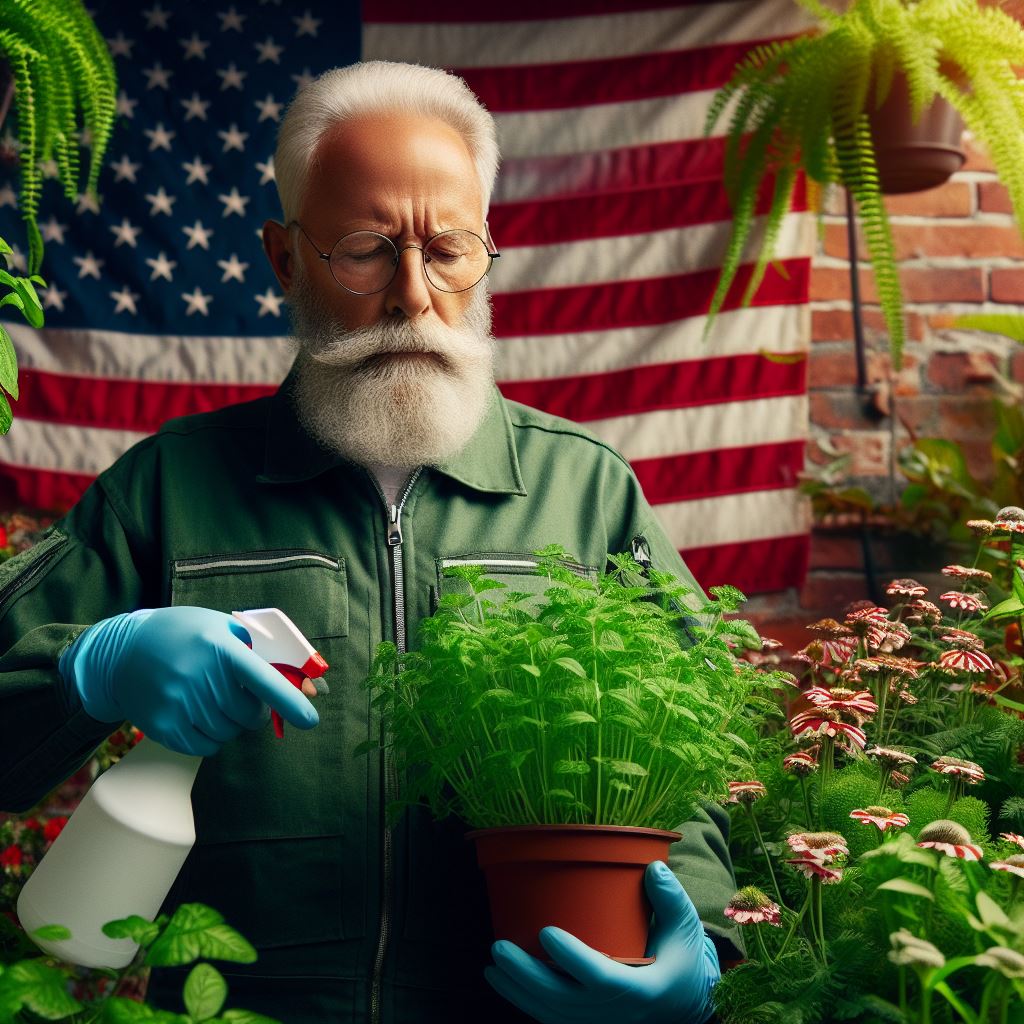No-Pesticide Plant Care: Tips & Tricks
Last Updated on March 2, 2024
Introduction
Growing plants and maintaining their health is a rewarding yet challenging task.
However, relying on pesticides is not always the best solution.
It is crucial to explore alternative methods for plant care to ensure the well-being of both the plants and the environment.
In this blog post, we will discuss various tips and tricks for effective no-pesticide plant care.
Our focus is on providing sustainable solutions that promote natural plant health without the use of harmful chemicals.
By avoiding pesticides, we can create a safer and healthier environment for ourselves, our families, and the ecosystem as a whole.
Overview of the blog post
Throughout this blog post, we will delve into practical techniques that empower gardeners and plant lovers to successfully manage pests and diseases without resorting to pesticides.
From preventative measures like companion planting and proper watering techniques, to natural remedies such as neem oil and garlic sprays, we will explore a wide range of methods to protect plants organically.
Additionally, we will discuss the importance of maintaining proper plant nutrition, as healthy plants have a stronger immune system, making them less vulnerable to pests and diseases.
We will also touch upon the significance of attracting beneficial insects to the garden by creating suitable habitats or using specific plants.
By implementing these strategies, you can develop a sustainable plant care routine that not only protects your plants but also contributes to preserving the biodiversity of our planet.
Let’s dive into the tips and tricks for effective no-pesticide plant care and embark on a journey towards green and thriving gardens.
Understanding Pests and Their Impact
Common types of pests that affect plants
Pests are a common nuisance for plant lovers and can wreak havoc on the health and appearance of your beloved greenery.
In order to effectively combat these pesky intruders, it is important to first understand the different types of pests that can affect plants.
- Insects: These small creatures are the most common type of pests that feed on plants. Some of the most notorious plant-damaging insects include aphids, caterpillars, and mealybugs. They can cause extensive damage by feeding on leaves, stems, and even the roots of plants.
- Diseases: Plants can also fall victim to various diseases caused by fungal or bacterial pathogens. Common plant diseases include powdery mildew, black spot, and root rot. These diseases can weaken plants, stunt their growth, and eventually cause their demise if left untreated.
- Weeds: While not typically thought of as pests, weeds can be a significant problem for plants. They compete with plants for resources such as sunlight, water, and nutrients, hindering their growth and development. Weeds are known to spread rapidly and can quickly overtake a garden if not controlled.
Potential damage caused by different pests
The potential damage caused by these pests can be devastating to your plants and overall garden.
It is important to recognize the signs of pest infestation and take action promptly to prevent further damage.
- Wilting and Yellowing Leaves: Insects such as aphids and caterpillars can cause leaves to wilt and turn yellow. This is due to their feeding on the plant’s sap and disrupting its nutrient flow.
- Holes and Chewed Leaves: Caterpillars and beetles are notorious for leaving behind a trail of damaged leaves with holes and chew marks.
- Stunted Growth: Plants that are infested with pests may experience stunted growth and fail to reach their full potential. They may also produce fewer flowers or fruits.
- Mold or Fungal Growth: Diseases caused by pathogens often result in the formation of mold or fungal growth on leaves or stems. This can further weaken the plant and lead to its death.
How pests can spread and multiply if not controlled
If pests are left uncontrolled, they can quickly spread and multiply, causing even greater damage to your plants.
Here are some ways pests can spread:
- Flying Insects: Insects such as aphids and whiteflies have the ability to fly and can easily move from one plant to another, spreading pests and diseases as they go.
- Crawling Insects: Many pests, including caterpillars and mealybugs, crawl from plant to plant, especially if they are overcrowded or lack sufficient food sources.
- Wind and Water: Some pests and their eggs can be carried by wind or water, allowing them to reach new plants and infest them.
- Contaminated Tools: Pests and diseases can also spread through contaminated gardening tools. It is important to clean and disinfect your tools regularly to prevent the transfer of pests.
In general, understanding pests and their impact is crucial for effective plant care.
By identifying the common types of pests, recognizing the potential damage they can cause, and understanding how they spread, you can take proactive measures to protect your plants and ensure their health and vitality.
Regular monitoring, early detection, and appropriate interventions are key to maintaining a thriving pest-free garden.
Read: Composting 101: Turn Waste into Garden Gold
Creating a Pest-Resistant Garden
Having a beautiful and thriving garden is a dream for many, but dealing with pests can quickly turn that dream into a nightmare.
Instead of resorting to harmful pesticides, it is essential to focus on prevention measures to create a pest-resistant garden.
By implementing these tips, you can ensure that your plants thrive without harming the environment.
Significance of prevention measures
- Keep your garden clean and tidy, removing any debris or dead plants that can attract pests.
- Regularly inspect your plants for signs of pests or diseases, catching them early on prevents further damage.
- Providing your plants with proper care, including sufficient watering and sunlight, boosts their natural defenses against pests.
Design a garden layout that discourages pests
- Place plants according to their sunlight and moisture requirements, ensuring they are healthier and more resistant to pests.
- Group plants with similar characteristics together, creating a microclimate that is less attractive to pests.
- Incorporate a diversity of plant species to confuse pests and discourage them from targeting a specific type.
Utilize companion planting to repel pests naturally
- Plant flowers and herbs that naturally repel pests, such as marigolds, lavender, or mint, among your vegetables or ornamentals.
- Interplant strongly scented herbs like rosemary or thyme with susceptible crops to mask their scent, making them less appealing to pests.
- Include beneficial plants like dill or fennel to attract beneficial insects that prey on pests, creating a natural control system.
Avoid monoculture and promote biodiversity
- Monoculture, planting only one type of crop, makes it easier for pests to spread and devastate an entire garden.
- Encourage biodiversity by growing a variety of plants, creating a balance that hinders pest population growth.
- Rotate crops each season to prevent pest build-up in the soil and interrupt their life cycles.
Implement physical barriers and traps
- Use row covers or nets to protect vulnerable plants, preventing pests like aphids, caterpillars, or birds from causing damage.
- Set up sticky traps or beer traps around your garden to catch and control pests like slugs or snails.
- Install fences or barriers to deter larger pests like rabbits or deer from entering your garden.
Habitats for beneficial insects and animals
- Build or buy insect houses, such as bee hotels or ladybug houses, to attract beneficial insects that prey on garden pests.
- Install bird feeders or birdbaths to encourage birds that feed on insects, helping to control pest populations naturally.
- Create small ponds or water features to attract frogs, toads, or dragonflies that feed on pests like mosquitoes or flies.
Regularly maintain and monitor your garden
- Inspect your plants and garden regularly for signs of pests or diseases, taking immediate action if necessary.
- Control weeds, as they can harbor pests and diseases, creating a breeding ground for garden problems.
- Practice good hygiene by cleaning tools and equipment after each use, preventing the spread of pests and diseases.
By following these tips and focusing on prevention rather than chemical intervention, you can create a pest-resistant garden that promotes the health of your plants while protecting the environment.
Remember, a healthy and diverse garden will naturally attract beneficial creatures that keep pests in check, ensuring your garden thrives in a natural and sustainable way.
Read: Urban Farming Essentials for Small Spaces
Implementing cultural practices
Proper watering and feeding techniques are crucial when it comes to maintaining a healthy garden without the use of pesticides.
By following these practices, you can ensure the well-being of your plants and minimize the impact of pests.
Here are some tips to consider:
Watering Techniques
- Water your plants deeply and infrequently to encourage deep root growth and prevent the development of shallow-rooted weeds.
- Use mulch to retain soil moisture and reduce water evaporation.
- Water early in the morning or late in the evening to minimize water loss through evaporation.
- Avoid overhead watering to prevent the spread of fungal diseases and minimize weed growth.
Feeding Techniques
- Use compost or organic fertilizers to provide essential nutrients to your plants.
- Follow the recommended feeding schedule for each plant species to avoid over or under-feeding.
- Apply fertilizer around the root zone rather than directly on the foliage or stem to prevent burning and ensure proper absorption.
- Regularly monitor your plants for nutrient deficiencies and adjust your feeding techniques accordingly.
Crop rotation plays a significant role in minimizing pest populations and promoting overall plant health.
It involves changing the location of crops in your garden each growing season to disrupt pest life cycles.
Benefits of implementing crop rotation
Pest Management
- Different pests are specific to certain plant families. By rotating crops, you can break the life cycle of pests that prey on a particular crop.
- Crop rotation reduces the buildup of pests in the soil, as they have a limited food source each season.
- It prevents the spread of persistent pests that reside in the soil and can easily reinfest the same crop.
Soil Health
- Crop rotation helps replenish soil nutrients by alternating crops with different nutrient requirements.
- Some plants, known as nitrogen-fixing crops, have the ability to convert atmospheric nitrogen into a usable form, enriching the soil for the following crops.
- Different crops have varying root structures that help improve soil structure and enhance water filtration and retention.
Maintaining a clean and weed-free garden is an essential aspect of no-pesticide plant care.
Weeds compete with your plants for water, nutrients, and sunlight, making them more vulnerable to pests.
Benefits of weed control
Reduced Pest Habitat
- Weeds provide a favorable habitat for pests, offering shelter, moisture, and alternative food sources. Eliminating weeds reduces the available resources for pests, minimizing their populations.
- Weeds can also harbor pests and diseases, which can easily spread to your cultivated plants.
Improved Plant Nutrition
- Weeds can deplete soil nutrients, leaving your plants nutrient-deficient. Removing weeds ensures that your plants receive all the necessary nutrients for healthy growth.
- Weeds can also release chemicals that inhibit the growth of neighboring plants. By eliminating weeds, you allow your plants to thrive without any growth-inhibiting factors.
By implementing cultural practices such as proper watering and feeding techniques, crop rotation, and weed control, you can effectively maintain a healthy garden without the use of pesticides.
These practices not only promote plant health but also contribute to a sustainable and environmentally friendly approach to gardening.
Read: Starting Organic Gardens: A Beginner’s Guide

Utilizing organic pest control methods
Organic pest control methods offer a safe and environmentally friendly approach to plant care.
By avoiding the use of harmful pesticides, gardeners can promote the health of their plants while minimizing their impact on the ecosystem.
In this section, we will explore different alternatives for organic pest control, including the use of beneficial insects and homemade remedies.
Organic pest control alternatives
- Organic pest control involves using natural products and methods to prevent and manage pest infestations.
- Unlike conventional pesticides, organic alternatives do not harm beneficial insects, wildlife, or human health.
- By adopting these methods, gardeners can create a balanced ecosystem in their gardens.
The use of beneficial insects to control harmful pests
- Beneficial insects such as ladybugs, lacewings, and praying mantises are natural predators of harmful pests.
- These insects can be attracted to the garden by planting specific flowers and herbs that act as their food sources.
- When released in the garden, they help keep the population of harmful pests in check, reducing the need for pesticides.
Homemade remedies like vinegar sprays and garlic-based pesticides
- Vinegar sprays: Mixing vinegar with water creates an effective solution for controlling common garden pests like aphids and mites. Spray this mixture directly on the affected plants, ensuring to cover both sides of the leaves.
- Garlic-based pesticides: Blending garlic cloves with water and a small amount of vegetable oil creates a potent pest repellent. Spray this mixture on plants to deter pests like caterpillars, beetles, and aphids.
Advantages of Organic Pest Control
- Environmental benefits: Organic pest control methods help maintain a healthy ecosystem by preserving beneficial insects and wildlife. They prevent the contamination of soil, water sources, and air by toxic chemicals, safeguarding the environment.
- Health benefits: Non-toxic organic pest control methods reduce the risk of exposure to harmful chemicals for both gardeners and consumers of the produce. Eliminating pesticide residues from plants contributes to better overall health and well-being.
- Long-term sustainability: By using organic pest control methods, gardeners create a sustainable cycle that reduces the dependence on synthetic chemicals. It promotes the natural resilience of plants, enabling them to combat pests and diseases on their own.
Taking a proactive approach to pest control without the use of pesticides is both feasible and beneficial.
Organic pest control methods empower gardeners to protect their plants while preserving the environment and promoting human health.
By attracting beneficial insects and utilizing homemade remedies, gardeners can create thriving gardens without relying on harmful chemicals.
So, let’s embrace organic pest control and nurture our plants naturally!
Read: Urban Permaculture: Sustainable Tips
Using Physical Barriers to Pest Control
Effectiveness of physical barriers in pest prevention
Physical barriers are effective in preventing pests from invading and damaging your plants.
Here are some tips on using them properly:
Row Covers
- Row covers are lightweight fabrics that act as a protective shield for your plants.
- They are placed directly over the plants, creating a physical barrier against pests.
- Row covers are particularly useful for protecting plants from insects and small mammals.
- Make sure the covers are securely anchored to the ground to prevent pests from getting underneath.
- Regularly check the covers for any tears or holes, and repair them immediately to maintain their effectiveness.
- When using row covers, it’s important to also provide sufficient ventilation to prevent overheating or moisture buildup.
Netting
- Netting is another effective physical barrier that helps in keeping pests away from your plants.
- Use netting specifically designed for gardening, with small mesh to prevent even the tiniest insects from entering.
- Install the netting securely around the plants, ensuring there are no gaps or loose ends where pests can enter.
- Regularly inspect the netting for any damage and repair or replace it as needed.
- Netting is particularly useful for protecting fruits and vegetables from birds, squirrels, and larger insects.
- Ensure the netting is not directly touching the plants as it may cause damage or prevent proper air circulation.
Importance of Maintenance and Monitoring
- While physical barriers are effective, they require proper maintenance and monitoring for optimal results.
- Regularly inspect the barriers for any signs of damage or wear and tear.
- Repair or replace damaged barriers promptly to ensure pests cannot find their way through.
- Monitor the barriers regularly for any pest activity. Check for signs of pests both inside and outside the barriers.
- Address any issues immediately. Remove any pests found and take preventive measures to avoid future infestations.
- Be mindful of the growth of your plants. Adjust the barriers accordingly to accommodate their size.
Using physical barriers is a sustainable and eco-friendly method of pest control for your plants.
Remember, prevention is better than cure. By utilizing these tips, you can effectively protect your plants from pests without the need for harmful pesticides.
In essence, physical barriers such as row covers and netting play a crucial role in preventing pests from damaging your plants.
They provide a physical barrier that pests cannot penetrate, keeping your plants safe.
Keep in mind that regular maintenance and monitoring are essential for the barriers to remain effective.
By implementing these strategies, you can enjoy a pest-free garden while promoting a healthy and sustainable environment.
Learn More: Soil Health in Small Spaces: Key Tips
Promoting plant health and resilience
Regular plant inspections
- Inspect your plants regularly to identify any signs of pest infestation or disease.
- Look for changes in leaf color, spots, wilting, deformities, or any unusual growth patterns.
- Early detection can prevent the spread of pests and diseases to other plants in your garden.
- If you notice any issues, take prompt action to address them.
Proper pruning and removing affected plant parts
- Pruning helps maintain the overall health and shape of your plants.
- Remove dead or diseased branches, leaves, or flowers to prevent the spread of pests and diseases.
- Make clean cuts and dispose of the pruned material properly, away from your healthy plants.
- Avoid over-pruning, as it can weaken the plant and make it more vulnerable to pests and diseases.
The role of healthy soil in preventing and managing pests
- Healthy soil provides a strong foundation for plant growth and resilience against pests.
- Amend your soil with organic matter to improve its structure, fertility, and water-retention capacity.
- Well-draining soil reduces the risk of root rot and other diseases caused by excessive moisture.
- Avoid over-fertilizing, as it can attract pests and create imbalances in the ecosystem.
- Promote beneficial insects and organisms that naturally control pests by providing them with a suitable habitat.
Paying attention to these aspects of plant care can greatly minimize the need for pesticides and chemical interventions in your garden.
By adopting natural and sustainable practices, you not only ensure the health and resilience of your plants but also contribute to a healthier environment.
Uncover the Details: Pollinator-Friendly Small Gardens: Tips
Delve into the Subject: Drought-Resistant Gardening Strategies
Conclusion
As discussed in the blog post, no-pesticide plant care offers several benefits for gardeners.
By following the provided tips and tricks, readers can create a thriving, pesticide-free garden.
Summarizing the key points covered in the blog post:
- Using companion plants can naturally deter pests and promote plant growth.
- Regularly inspecting plants and removing any diseased or infested leaves is crucial.
- Natural pest control methods like introducing beneficial insects and using organic sprays are effective.
- Creating healthy soil through composting and mulching helps plants build resistance against pests.
- Practicing good garden hygiene by cleaning tools and disposing of plant debris can prevent pest infestations.
No-pesticide plant care provides several benefits, such as promoting biodiversity, protecting the environment, and ensuring the health of plants, humans, and beneficial insects.
In a nutshell, readers are encouraged to implement the tips and tricks shared in the blog post to create a thriving, pesticide-free garden.
By doing so, they can enjoy the beauty of their plants while contributing to a healthier ecosystem.


